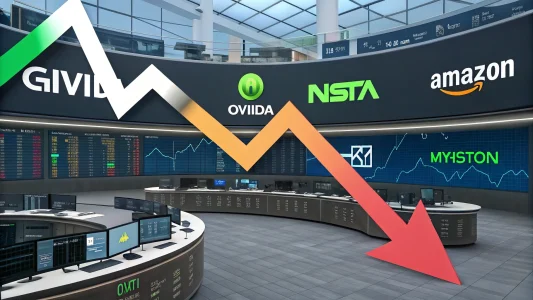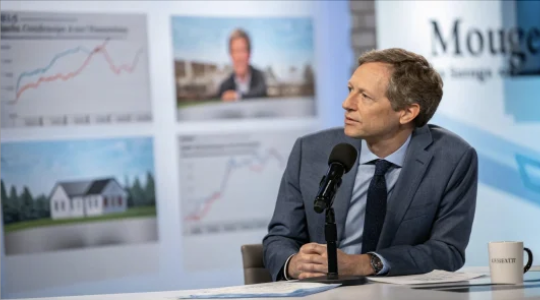I am Taylor Sohns, CEO of LifeGoal Wealth Advisors, a CIMA and CFP. My job is to read the market’s mood and explain what it means for your money. Last week, the market swung sharply due to shifting expectations for interest rates. The cause was neither a big earnings surprise nor a data shock. It was the Federal Reserve’s messaging that pulled investors in two directions.
Stocks fell early in the week. Then they rocketed higher on Friday. The swing lined up with sharp shifts in the odds of a December rate cut. One comment pushed the odds down. Another pushed them up again. That is not a stable setup for markets or for investors trying to plan.
Table of Contents
ToggleWhat Changed in a Single Week
On November 1, traders saw a very high chance that the Fed would cut rates in December. The implied probability sat near 94%. That kind of number sets a firm expectation. It tells you most investors were positioned for easier money soon.
Then, early last week, a Fed governor reminded everyone that inflation has stayed above the 2% goal for years. The message also suggested that recent data were moving in the wrong direction. That comment hit the market like a bucket of cold water.
“Inflation’s been above the 2% target for four and a half years, and it’s trending the wrong way.”
The odds of a December cut fell to about 36% after that. Stocks sold off hard. Higher-for-longer interest rates would weigh on borrowers, earnings, housing, and valuations. Many investors moved to the sidelines or hedged risk.
By Friday, the tone flipped again. The New York Fed president said there is room for adjustments in the near future.
“There’s room for interest rate adjustments in the near term.”
The market took that as a green light for a cut. The odds jumped to around 75%. Stocks ripped higher into the close. The week closed with a rally that masked the churn beneath the surface.
View this post on Instagram
Two Camps Inside the Fed
Here is the core issue. The Fed is split. One camp thinks inflation is still sticky. They point to recent data that shows prices firming in some areas. They highlight services inflation and shelter, which tend to cool slowly. Their view: do not cut yet.
The other camp sees a cooling labor market. Job openings have eased. Wage growth has slowed. Hiring has become more selective. Their view: start cutting soon to support growth and reduce the risk of a sharper slowdown.
Both groups are making their case in public. They are trying to guide expectations. But the mixed messages confuse the market. Investors have to handicap each comment and try to guess which camp will win the December meeting. That leads to big swings in pricing and sentiment.
- November 1: Markets priced a 94% chance of a December cut.
- Early last week: A Fed governor’s inflation warning drove odds down to 36%.
- Friday: A New York Fed comment pushed odds back up to 75%.
- Stocks fell early in the week and surged on Friday.
Why Words Move Markets This Much
The market trades on expectations as much as on facts. Rate expectations drive borrowing costs, discount rates, and risk appetite. When the expected path of rates changes fast, almost every asset gets repriced. That includes stocks, bonds, housing, and even cash decisions.
Forward guidance is the Fed’s tool for shaping those expectations. The Fed knows this. Its members pick words with care. But they do not all agree on the next step. So the guidance shifts with each speech, panel, or interview. That leaves investors chasing the latest signal and bracing for the next one.
Think about the chain reaction. A hint of a cut lowers yields. Lower yields lift growth stocks and interest-rate sensitive sectors. Housing feels a tailwind. The dollar softens. Commodities can move too. Then a hawkish comment reverses it. Yields rise. Growth stocks sag. Defensive sectors catch a bid. Rinse and repeat.
The Data Each Side Is Watching
Inflation hawks point to recent sticky readings. Service(s) prices remain firm. Shelter inflation has eased from its peak but still bites. Energy and food can bounce. They also worry that inflation expectations could drift if the Fed eases too soon. Their fear is a second wave of inflation that would be harder to fight.
The growth-focused group highlights a cooling job market. They see job openings drifting down. Layoffs remain low, but hiring momentum has slowed. Wage growth has softened. Consumer savings from the pandemic have dwindled. Credit card delinquencies have ticked up. Their fear is a harder landing if policy stays tight.
Both stories can be true at the same time. That is why the messaging feels messy. The economy is not overheating, but it is not weak either. Inflation is not raging, but it is not at the target. That gray zone forces tough trade-offs.
How I Read the Setup
I see a Fed that wants flexibility. Officials are keeping the option of a cut open, but they do not want to promise it. They want to preserve credibility on inflation. They also want to soften the risk of an economic stall. That balancing act produces headlines that seem to clash.
Will they cut in December? The odds say maybe. But the better answer is this: the next data points will matter more than any speech. A softer inflation print would lift the odds again. A hot print would sink them. A weak jobs report would push the Fed toward easing. A strong report would argue for patience.
Markets are pricing relief. That can fuel rallies. But it also raises the risk of disappointment if the data does not confirm. In that case, stocks could give back gains, and yields could climb. The more the market front-runs a cut, the more it can recoil if it does not arrive on time.
Practical Steps for Investors
Investors do not control the Fed, but we do control the process. Here are practical ways to handle the noise and the swings.
- Anchor to a plan. Align risk with time horizon, not with headlines.
- Keep diversification. Rate shocks hit assets differently. Balance helps.
- Stagger bond maturities. Laddering reduces timing risk around policy moves.
- Hold quality. Strong balance sheets handle higher rates and slowdowns better.
- Watch data, not quotes. Focus on inflation and jobs, not daily odds swings.
I also like to think in scenarios. If the Fed cuts in December and hints at more, long-duration assets can lead. Bonds rally. Growth stocks lift. Cyclical sectors may catch a bid if growth steadies. If the Fed holds and stays hawkish, short-duration bonds and cash remain attractive. Value and defensive sectors may prove steadier. Mixed guidance produces chop, which favors balance and discipline over big bets.
Lessons From a Volatile Week
Last week taught a few simple lessons. First, the Fed’s words carry weight. One line can move trillions. Second, policy is not on autopilot. Decision-makers are split and still reading the data. Third, markets can swing hard without any change in actual policy. That means risk management matters even more.
It also showed that investors crave clarity. Unfortunately, clarity is rare at policy turning points. We will get more speeches. We will get more data. Odds will swing again. The key is to avoid reacting to every push and pull.
For long-term investors, the rule remains the same. Focus on quality assets, steady savings, and a time-tested mix. For shorter horizons, be explicit about risk limits. Use cash, short-duration bonds, or hedges where needed. Keep position sizes sensible when events can flip the narrative in a day.
What to Watch Next
The next few reports will be key. Inflation data will show if price pressures are easing again. Wage growth and hours worked will help gauge the pace of labor cooling. Claims and job openings will fill in the picture.
Also watch Fed speakers, but weigh them against the data. A single hawkish or dovish line can move markets, as we saw. Yet the final decision will lean on the numbers. The December meeting will sit at the center of it, but it will not be the last word on policy. The path into next year still depends on how inflation and growth evolve.
My Takeaway
The market did not swing last week because investors lack discipline. It swung because the signals were mixed and powerful. The inflation camp raised its voice. The growth camp answered. The odds snapped back and forth, and prices followed.
Here is the bottom line from my seat. The Fed is keeping options open. That is the right move in a cloudy economy. But it creates noise. The best response is patience, process, and attention to the data that truly matters. Stay flexible, but avoid chasing every headline. The next trend will first show up in the numbers.
As we head into December, expect more volatility. Be ready for quick shifts in tone and pricing. Have a plan, and stick to it when the tape gets loud.

















